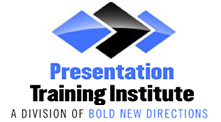*Do you know the purpose of the presentation?
The answer to this question will help you determine what message to focus on and which content is appropriate to include.Â
* Do you know your audience?
 Are you presenting to colleagues, senior level executives, customers, or the general public? The more you know about your audience the better you can tailor your message to meet their needs.Â
* Do you have an outline of your presentation?
While it’s certainly not necessary (or recommended) to memorize your entire presentation, you should definitely have an outline to help you stay on track. This ensures your presentation flows smoothly from one topic to the next and it helps you have a general outline to follow when it comes time to present.Â
*Do you have a strong opener?
Every presentation should begin with an attention-grabbing opener. This is your chance to capture audience attention, establish credibility, and set the scene for the remainder of your presentation.Â
*Do your main points have support from visual aids?
Research suggests that visuals are important for helping audiences understand and retain material. Therefore, you want to incorporate visual aids into your presentation so you can more effectively drive home your message.Â
* Have you visited the presentation venue?
Make sure to visit the venue ahead of time so you can familiarize yourself with things like lighting, spacing, and audio/visual equipment.Â
*Does your presentation meet the time requirements?
Make sure you know the time constraints for your presentation so you don’t go over the allotted time. You also need to be mindful of keeping your presentation concise and avoid rambling. Otherwise, you will lose your audience.Â
*Are your slides concise and easy to read?
There is nothing worse than a text-heavy slideshow. Remember that your slides should serve as nothing more than a guide. YOU are the main source of information…NOT the slides. Keep them short and to the point and make sure the font is large enough to be seen from the back of the room.Â
*Do you have a strong conclusion?
Just as it’s important to have a strong opener, you want to close with a strong conclusion as well. This is your last chance to drive your message home so you want to leave audiences with something memorable.Â
*Have you practiced and rehearsed?
One of the most important components of any presentation delivery is practice. Practice in front of a mirror as well as in front of friends or family. Invite feedback from them so you can improve any areas that may need work. It’s also a good idea to record yourself and play it back so you can see exactly what your audience will see. The more you practice, the more polished and confident you will be with your delivery.Â
